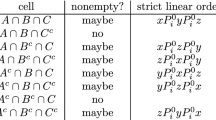Abstract
I introduce the notion of circular domains and prove that on any circular domain there is no strategy-proof and nondictatorial social choice function. Moreover, I show that on any proper subset of a minimal circular domain, there exists a group strategy-proof and essential social choice function. These results together detect the minimal size of the domains over which the incompatibility arises with respect to pairs of democratic-incentive requirements (nondictatorial, strategy-proof) and (essential, group strategy-proof).
Similar content being viewed by others
References
Aswal N, Chatterji S, Sen A (2003) Dictatorial domains. Econ Theory 22: 45–62
Barberà S, Berga D, Moreno B (2009) Individual versus group strategy-proofness: when do they coincide? Barcelona Economics Working Paper Series WP372
Benoît J-P (2000) The Gibbard–Satterthwaite theorem: a simple proof. Econ Lett 69: 319–322
Black D (1948) On the rationale of group decision-making. J Polit Econ 56: 23–34
Blair D, Muller E (1983) Essential aggregation procedures on restricted domains of preferences. J Econ Theory 30: 34–53
Chatterji S, Sen A (2008) Tops-only domains, Mimeo
Dogan E, Sanver MR (2007) On the alternating use of “unanimity” and “surjectivity” in the Gibbard–Satterthwaite theorem. Econ Letters 96: 140–143
Gibbard A (1973) Manipulation of voting scheme: a general result. Econometrica 41: 587–601
Kim KH, Roush FW (1980) Special domains and nonmanipulability. Math Soc Sci 1: 85–92
Le Breton M, Zaporozhets V (2009) On the equivalence of coalitional and individual strategy-proofness properties. Soc Choice Welfare 33: 287–309
Moulin H (1980) On strategy-proofness and single peakedness. Public Choice 35: 437–455
Özyurt S., Sanver MR (2009) A general impossibility result on strategy-proof social choice hyperfunctions. Games Econ Behav 66: 880–892
Reny PJ (2001) Arrow’s theorem and the Gibbard–Satterthwaite theorem: a unified approach. Econ Lett 70: 99–105
Sanver MR (2007) A characterization of superdictatorial domains for strategy-proof social choice functions. Math Soc Sci 54: 257–260
Satterthwaite MA (1975) Strategy-proofness and Arrow’s conditions: existence and correspondence theorems for voting procedures and social welfare functions. J Econ Theory 10: 187–217
Sen A (2001) Another direct proof of the Gibbard–Satterthwaite theorem. Econ Lett 70: 381–385
Author information
Authors and Affiliations
Corresponding author
Rights and permissions
About this article
Cite this article
Sato, S. Circular domains. Rev Econ Design 14, 331–342 (2010). https://doi.org/10.1007/s10058-010-0102-y
Received:
Accepted:
Published:
Issue Date:
DOI: https://doi.org/10.1007/s10058-010-0102-y




